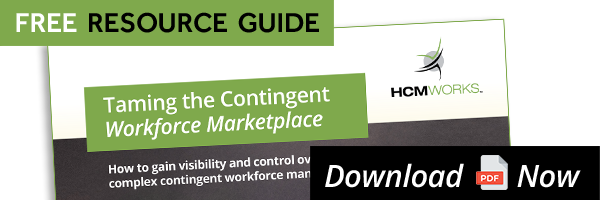If you are the CEO or manager or a medium-to-large sized enterprise then it’s likely you will have already tapped into the contingent workforce. Despite this, many organizations are still struggling to understand exactly what a contingent worker is and how these workers can help their company grow.
In this blog, HCMWorks will look at what exactly a contingent worker is, why these workers have grown dramatically over the past few years, how your organization can benefit from using the contingent workforce and why a management strategy is essential if your business is to reap the full rewards.
What is a contingent worker?
Contingent workers, which make up the gig economy, are temporary workers that are hired on a contingency basis.
They are generally made up by freelancers, independent contractors, consultants, part-time workers and other outsourced and non-permanent workers who are hired for a specific period of time or on a per-project basis. While contingent workers have been traditionally perceived as lowly paid workers who filled, mostly, unskilled jobs - this is no longer the case. In fact, contingent workers are now highly skilled and often seek out contingent work to fit their way of life.
It allows workers to work from where they want, at what time they want, and with the company or project, they feel most passionate about.
Contingent workers are hired by companies to undertake specific tasks and projects that they possess the unique skills and qualifications to complete. Once the project is over the contingent worker will leave the company, but if the worker and the business have a good relationship then they can be called on again when another project comes up.
The growth of the gig economy
Due to the advantages that contingent work brings to both an organization and the worker, the number of contingent workers has risen significantly over the past few years.
That’s exactly what a new study from Staffing Industry Analysts, titled ‘The US Gig Economy’, found. The report found that US revenue in the gig economy totalled $1.3 trillion in 2018 and it included 53 million workers.
The study, which uses data from an SIA survey as well as data from the US Census Bureau, the US Bureau of Labor Statistics and other research, found that of 53 million workers, 10.1 million were assigned as temporary workers by staffing firms and 7.9 million were human cloud workers.
It also found that human cloud workers brought in $39 billion in revenue, agency temporary workers brought in $128 billion, and the largest group in terms of revenue generated in 2018 were self-employed workers with no employees at $800 billion.
How a contingent workforce will benefit your organization
From these statistics, as well as other research that estimates contingent workers now make up around 30-40 per cent of the entire US workforce, it’s clear that the contingent workforce now makes up a huge part of any organization’s workforce targets.
But how exactly do contingent workers specifically benefit your company? We’ve listed just a few of the key ways here:
Overcome a shortage in skilled workers: While record-breaking unemployment is fantastic for the US, it has resulted in a significant shortage in skilled workers which is having a huge impact on the acquisition of top talent. In fact, according to global organizational consulting firm Korn Ferry’s 2018 study, the United States faces a critical shortage of skilled workers that could cost the country $1.748 trillion in lost revenue by 2030 - the equivalent of 6 per cent of the country’s economy. Thankfully, contingent workers give your company access to workers with the specialized skills that you need for success.
Increased flexibility: The contingent workforce will give your organization the flexibility it needs to respond to rapidly changing market conditions. You’ll be able to scale your workforce up and down in real-time depending on the specific needs of your company. Your clients will no longer have to wait for you to ensure you have the right skills and resources in place.
Faster and more cost-effective way of hiring top talent: Contract workers can be brought in rapidly to fill open positions or skills gaps that your company is experiencing - meaning there’s no long waiting period to fill permanent employee vacancies and no worry that you might have hired the wrong worker. Not only that, but you’ll also reduce the huge costs that come with hiring permanent workers - from onboarding costs, sick pay, vacation time and much more.
Why contingent workforce management is essential
Unfortunately, realizing the benefits that come with the contingent workforce isn’t as easy as hiring a few contingent workers and hoping for the best. In fact, it’s unlikely that your organization will have the expertise or know-how to implement a successful contingent workforce management program.
By partnering with a managed services provider (MSP) that has expertise in the contingent workforce, your company will be able to ensure it has the visibility and control over temporary workers that’s needed for improved hiring decisions, cost reductions and efficiency improvements.
Want to learn how HCMWorks can help manage your contingent workers? Contact us today for more information.



